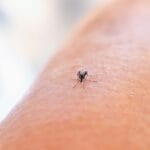Bed bugs can seem like an insurmountable problem, but with the right strategy, you can successfully get rid of them. Here’s a guide on how to naturally and effectively eliminate these unwelcome guests from your home.
Main Points
- Bed bugs are small, reddish-brown bugs that cause itchy bites and can infest your home.
- It’s essential to clean and declutter when trying to control a bed bug infestation.
- Heat treatments like steam cleaning can be very effective against bed bugs.
- Pesticides can be used, but they must be chosen and used carefully to be safe and effective.
- Preventative measures like using protective covers and regular inspections are crucial to keep bed bugs away.
Know Your Enemy: How to Identify Bed Bugs
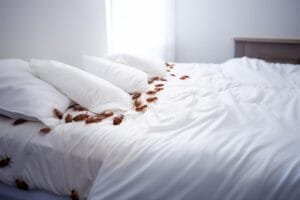
Before you can deal with an infestation, you need to be sure that you’re dealing with bed bugs. They’re sneaky, good at hiding, and only come out to feed on your blood at night, which makes them hard to find.
Getting to Know Bed Bugs: What They Look Like and How They Act
Bed bugs are roughly the size of an apple seed and have a flat, oval body. They are usually reddish-brown, but after feeding, they become swollen and a deeper red. They don’t have the ability to fly or jump like some pests, but they can move quickly across floors, walls, and ceilings.
These pests are primarily nocturnal, venturing out to feast when the sun goes down. They can sneakily snack on their hosts for as long as 10 minutes at a time. After their meal, they scurry back to their hideouts to digest and procreate.
Here’s the scary part: bed bugs can lay hundreds of eggs during their lifespan, and these eggs are about the size of a speck of dust, making them extremely difficult to get rid of.
How to Spot an Infestation: What to Keep an Eye Out For
Seeing live bed bugs is the most clear-cut sign of an infestation, but because they’re experts at concealment, you’ll probably see other signs before you see the bugs themselves. Keep an eye out for:
- Stains of a rusty or reddish color on bed sheets or mattresses, which are caused by bed bugs being crushed.
- Dark spots that are actually bed bug excrement and may bleed on the fabric like a marker would.
- Eggs and eggshells that are tiny (about 1mm) and pale yellow.
- Live bed bugs. Even though they are good at hiding, you might see them in the crevices of your mattress, box spring, bed frame, and headboard.
Now that you understand what you’re dealing with, let’s discuss the plan of action.
Step One: Cleaning Your Space
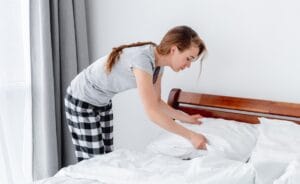
Start off by giving your home a good clean. While this won’t eliminate bed bugs completely, it will decrease their population and make other extermination methods more successful.
De-cluttering: Minimizing Bed Bug Hideouts
Bed bugs thrive in cluttered spaces as it provides numerous hiding spots for them. Hence, de-cluttering is a vital part of managing an infestation. Here are some tips:
- Clear away personal belongings such as soft toys, electronic devices, and books from your bed and the surrounding area.
- Store these items in airtight plastic bags until you have the chance to clean them, heat-treat them, or otherwise ensure they are free of bed bugs.
- Maintain a clean and clutter-free space to minimize potential hiding places.
Keep in mind, the aim is to create a living space that’s unsuitable for bed bugs. For more information, review our bed bug prevention guide to secure and protect your home.
Hot Stuff: Employing Heat to Destroy Bed Bugs
One of the most potent natural defenses against bed bugs is heat. These critters can’t stand high temperatures, making steam cleaning a potent weapon. Here’s how to use this tool:
Employ a steamer on your bed, bed frame, and other pieces of furniture where you’ve noticed signs of bed bugs. The heat from the steam can get through fabric surfaces and exterminate bugs and eggs on contact. It’s crucial to ensure that the steamer you use can reach a minimum of 200°F, which is the temperature required to kill bed bugs.
Steam cleaning is a great way to get rid of bed bugs, but you need to be diligent. Make sure you go over the same spot several times and focus on any nooks and crannies where bed bugs might be hiding.
Next up, we’ll discuss the wise use of pesticides and how to set up barriers to keep these night-time nuisances from coming back.
Picking the Perfect Pesticide
Natural methods are great, but sometimes you have to step up your game. Pesticides can be a good weapon in your arsenal against bed bugs, but you need to be careful. Make sure you choose products that are specifically designed to combat bed bugs and are approved by the Environmental Protection Agency (EPA).
Make sure to thoroughly read the label and follow all the directions for DIY pest control. This will keep you, your loved ones, and your pets safe. Also, try to find pesticides that work in different ways to avoid resistance, which is something bed bugs are well-known for developing.
Think about using desiccants. These are pesticides that don’t use chemicals. Instead, they destroy the bugs’ protective outer coating. This causes the bugs to dehydrate and die. Bed bugs can’t become resistant to desiccants. This is because they work through a physical process, not a chemical one.
How to Apply Pesticides Effectively
Getting rid of bed bugs requires careful application of pesticides. Concentrate on the areas where bed bugs are likely to hide: your mattress, box spring, bed frame, and any furniture close to your bed. Follow the instructions on the pesticide label, which usually recommend a thin, uniform application.
Unless the label explicitly states that it’s safe, avoid using pesticides on bedding or linens. Also, never combine different pesticides. This can not only be hazardous but often it’s not effective.
Once you’ve applied the treatment, be patient. It can take a few hours or even days for the pesticide to fully do its job. Monitor the treated areas for any signs that the bed bugs are still active.
Keep Them Out: Securing Your Home
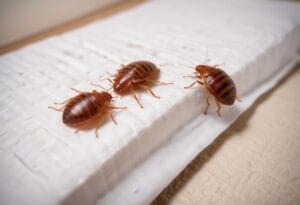
After you’ve cleaned your home, it’s important to make sure bed bugs can’t get back in. You can do this by sealing any cracks in the walls and floors, and by using mattress covers that are specifically designed to keep out bed bugs.
Another thing you can do is use interceptors. These are little cups that go under the legs of your bed. They trap bed bugs that are trying to climb up. This is an easy and effective way to keep an eye out for bed bugs and stop them from getting to you when you’re sleeping.
Establishing a Secure Perimeter Around Your Bed
To protect your sleeping space from bed bugs, try turning your bed into a fortress. Move your bed away from the wall, and ensure that your bedding doesn’t touch the ground. Install the previously mentioned interceptors on all bed legs, and think about using double-sided tape around the bed frame for extra security.
Maintain cleanliness in your bedding and eliminate bed bugs by frequently washing and heat-drying. Using heat is a guaranteed method to exterminate any bed bugs or eggs that may have ended up on your sheets.
Are Natural Repellents Effective?
Many people are talking about natural bed bug repellents such as essential oils, diatomaceous earth, and baking soda. While some individuals believe in these methods, it’s crucial to realize that their effectiveness isn’t always supported by strong research.
Yet, you can find an ally in diatomaceous earth. This natural element can eliminate bed bugs by puncturing their outer shell. Always make sure you use food-grade diatomaceous earth and apply it with caution to prevent breathing it in.
Keeping the Castle Safe: Continuous Prevention Tactics

Once you’ve tackled an infestation, it’s crucial to stay alert to stop it from happening again. Here are a few tactics to keep bed bugs away:
- Make sure to regularly check your bed for signs of bed bugs.
- Try to vacuum as often as possible to catch any bugs that may have been missed or newly arrived.
- Be wary of bringing used furniture into your home, and make sure to check it for bed bugs.
- When you’re traveling, keep your luggage off the floor and check hotel rooms for bed bugs before you get comfortable.
Keep in mind, bed bugs are great at hitchhiking. They can travel on clothes, luggage, and furniture, so it’s always better to be proactive than reactive when dealing with these bugs.
These strategies will help you keep your home bed bug-free and give you the peace of mind you deserve.
Why You Should Use Protective Covers
Bed bugs can be kept at bay by using protective covers on your mattress and box spring. The design of these covers makes them impenetrable to bed bugs, trapping any that are already there and stopping new ones from making their way in.
When you’re shopping for a mattress cover, make sure it’s one that’s specifically designed to keep bed bugs out. It should be made with sturdy seams and a zipper that bed bugs can’t get through. After you’ve put it on your mattress, check it often to make the sure there are no tears or holes that could let bed bugs in.
These covers not only assist in keeping bed bugs at bay, but also block dust mites and other allergens, thereby maintaining a more sanitary sleeping space.
Consistent Check-ups and Cleanings
Preventing bed bugs starts with a consistent check-up and cleaning routine. Every week, give your bed and the surrounding area a thorough check for any signs of bed bugs. Use a flashlight and magnifying glass to look into the seams, folds, and crevices. For more detailed information on what to look for, visit Bed Bugs – What They Are and How to Control Them.
Moreover, tidy up your area to reduce potential hideouts, and vacuum on a regular basis to trap any bed bugs or their eggs. After vacuuming, quickly dispose of the vacuum bag in a tightly sealed plastic bag to stop any captured bed bugs from getting away.
By making these habits part of your daily routine, you’ll be in a better position to notice an infestation early and act quickly to keep your home free of bed bugs.
Knowing When to Get Help: Hiring a Pest Control Expert
Even the most meticulous homeowners might reach a point where they can’t handle a bed bug infestation on their own. If you’ve tried the methods I’ve suggested and you’re still not getting a good night’s sleep because of these pests, it might be time to call a professional. Pest control experts have the knowledge and equipment to handle severe infestations more effectively than the average person.
If you call a pest control company, they’ll usually start with an inspection to make sure there are bed bugs and to see how bad the infestation is. Then, they’ll come up with a plan to get rid of the bed bugs. This plan might include more advanced heat treatments, insecticides, and even dogs trained to find bed bugs to make sure they get rid of all the bed bugs.
Crucially, professional exterminators will typically offer a follow-up service to ensure that the bed bugs have been completely eradicated. If you’re at your breaking point, don’t be afraid to call in the experts. They can offer you peace of mind and a definitive solution to your bed bug problem.
FAQs
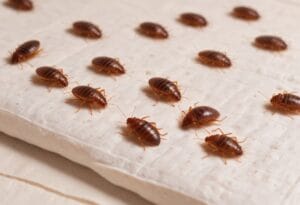
Let’s take a moment to answer some of your burning questions about bed bugs and how to get rid of them. The more you know about these little critters, the better you can protect your home from a bed bug invasion.
Having this information will not only help you deal with any current infestations, but also prevent future ones. Remember, being informed is the best defense, especially when it comes to bed bugs.
Do bed bugs transmit diseases to people?
Luckily, bed bugs are not recognized as carriers of diseases to people. Though their bites may be itchy and uncomfortable, the main issue with bed bugs is the nuisance and psychological distress they can provoke. Nonetheless, it’s always a smart idea to keep good hygiene and treat bites to avoid secondary infections.
How long can bed bugs survive without a host to feed on?
Bed bugs are unexpectedly tough and can live for many months without a meal. This is why it’s crucial to stay alert even after you believe an infestation has been handled. Regular checks and preventive actions are critical to ensuring these pests don’t return.
Are bed bugs capable of becoming immune to pesticides?
Indeed, bed bugs can become immune to specific pesticides, especially if the same substance is used repeatedly over time. This is why I advise changing treatments and using a variety of methods, including heat and physical barriers, to effectively fight these pests.
What should I do with my clothes and bed sheets after treating for bed bugs?
After treating for bed bugs, you should wash all your clothes and bed sheets in hot water to kill any leftover bed bugs or eggs. Use the highest heat setting on your washer and dryer that the fabric can handle. For items that can’t be washed, you might want to use a steamer or put them in a sealed bag with a pest strip for a few weeks.
What steps can I take to prevent bringing bed bugs home after traveling?
Traveling is one of the main ways that bed bugs find their way into homes. To protect yourself, it’s recommended that you keep your luggage on a rack instead of on the floor or bed, thoroughly inspect hotel rooms for any signs of bed bugs, and wash all of your clothes in hot water as soon as you get home. It’s always easier to prevent an infestation than to deal with one after it has started.
Hopefully, you now feel ready to face a bed bug infestation and keep these night-time nuisances from ruining your tranquility. Keep in mind, persistence and determination are your weapons in this fight. Remain alert, and you’ll emerge victorious. Best of luck, and may your home forever be free of bed bugs!




